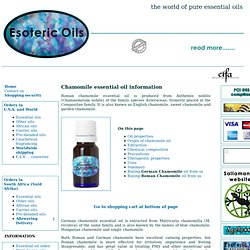

Chamomile- Side Effects and Benefits. Botanical Name chamomilla, matricaria recutita, Chamomilla recutita.

Other Common Names Mayweed, scented mayweed, pinheads, pineapple weed, german-hundskamille. Habitat This annual herb is originally from Europe but has become naturalized to most continents. Plant Description The stem of the chamomile plant is erect and hollow. Plant Parts Used The entire above ground portion of the plant can be used. German Chamomile (Matricaria recutita) Chamomile is used for its anti-inflammatory, antibacterial, antispasmodic and sedative properties.
It is also used internally to treat spasms and inflammation of the digestive tract. In ancient Anglo-Saxon days, the chamomile flowers were chewed to relieve toothaches, which coincides with today’s use as a mouth rinse for sore gums and as an herbal treatment for gingivitis and inflammations of the oral cavity. Chamomile is often used to treat nervous disorders such as insomnia, anxiety and nervous tension. It is often added to cosmetics as an anti-allergen. Chamomile oil - information on the origin, source, extraction method, chemical composition, therapeutic properties and uses. Roman chamomile essential oil is produced from Anthemis nobilis (Chamaemelum nobile) of the family species Asteraceae, formerly placed in the Compositae family.

It is also known as English chamomile, sweet chamomile and garden chamomile. German chamomile essential oil is extracted from Matricaria chamomilla (M. recutica) of the same family and is also known by the names of blue chamomile, Hungarian chamomile and single chamomile. Both Roman and German chamomile have excellent calming properties, but Roman chamomile is more effective for irritation, impatience and feeling disagreeable, and has great value in treating PMS and other menstrual and menopausal problems, while German chamomile is superbly effective on the skin, not only to sooth and calm, but to heal and for tissue regeneration. Oil properties Origin of Roman and German chamomile oil To the Egyptians it was a herb dedicated to the sun, to cure fevers, and to the moon, for its cooling ability.
Extraction Chemical composition Uses. Henriette's Herbal Homepage. Usually, people pick just the flowers.

And that is a waste of good herb: the stems of chamomile ( Matricaria recutita ) are perfectly useful, if weaker than the yellow flower. It's easiest to just pull up a bunch of whole plants, roots and all - they're annuals which lean on one another, and their taproots are really pretty small. Pic : Drying chamomile. Discard any flowers and stems with aphids, pick off snails, discard flowers with spiders, and check for other infestations.
If your plants are in full flower they're about 1/2 m tall (perhaps 1.5'). Let dry in a shady airy spot for 7-10 days. You can't dry chamomile in bundles hanging down; the yellow part of the flowers is the strongest part of chamomile, and the yellow bits fall off as the flowers dry. The usual test of dry herb, "stems break, they don't bend", doesn't work with chamomile, as the stems are brittle and break when fresh, too. Relaxing With Chamomile. Chamomile is an herb that brings memories, relaxation and joy.

It's used in the bath, as a comforting tea and in cosmetic recipes. We'll be profiling two types of chamomile-German (Matricaria recutita-formally chamomilla) and Roman (Anthemis nobilis, Chamaelmelum nobile). Both have many similarities as well as some distinct differences. Roman Chamomile is a perennial which is hardy to Zone 4, and sometimes to Zone 3. If you are unsure because of harsh winters you may mulch the plants for extra protection. Roman Chamomile has some enchanting uses in the garden and landscape that have been enjoyed for centuries. Another charming idea comes from the 19th Century gardens when seats were created by mounding the soil and planting chamomile thickly over the entire mound, or seat.
German Chamomile is an annual that grows 2-3 foot tall and will self sow if you leave some of the flowers on the plant when you harvest. How do you decide which chamomile to grow? Chamomile Tea: New Evidence Supports Health Benefits. For centuries, people who’ve felt sick or stressed have tried drinking chamomile tea as a medicinal cure-all.

Now, researchers in England have found new evidence that the popular herbal tea may actually help relieve a wide range of health ailments, including colds and menstrual cramps. Their study is scheduled to appear in the Jan. 26 issue of the American Chemical Society’s Journal of Agricultural and Food Chemistry, one of the Society’s peer-reviewed journals. ACS is the world’s largest scientific society. “This is one of a growing number of studies that provide evidence that commonly used natural products really do contain chemicals that may be of medicinal value,” says study leader Elaine Holmes, Ph.D., a chemist with Imperial College London. “The healthcare industry is placing increasing emphasis on functional foods including natural remedies, yet little work has been conducted on the long term effects of such products on human biology.”